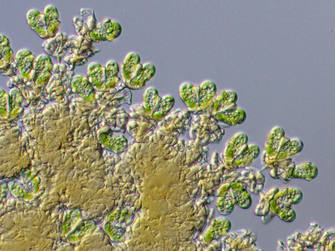« Prev Next »

Apparently, B. braunii naturally produces a triterpene oil comparable in hydrocarbon content to petroleum or natural gas. While too slow of a producer on its own to be a valuable energy resource, researchers from the University of Kentucky have isolated its oil-producing genes and genetically engineered a yeast that expresses a similar oil at faster rates.1 As I've subsequently learned, these experiments not only give a first-hand glimpse of hydrocarbon production hundreds of millions of years ago, but also offer a blueprint for a long-sought commodity — a renewable replacement for oil and coal shale.
Although seemingly far-fetched, the idea of developing algae as a source of power has actually been around for nearly forty years. After the oil crisis of the early 1970s, for example, US President Jimmy Carter established the Aquatic Species Program (ASP) in 1978 under the US Department of Energy as part of a nationwide push for energy independence. According to an ASP report, the initial "main focus of the program... was the production of biodiesel from high lipid-content algae grown in ponds, utilizing waste CO2 from coal-fired power plants."
As they recycle CO2 waste from burnt coal, these strands of microalgae produce natural oils that, after treated with transesterification, turn into biodiesel that releases significantly less greenhouse gases than petroleum.2 Unlike ethanol biodiesel made from corn or potatoes, microalgae biodiesel can also be grown with salt water and be harvested year-round on a smaller area of land.3 These features alone make microalgae biodiesel an attractive alternative energy source, and may be responsible for why similar programs to ASP can be found in many countries including Australia, New Zealand, China, Japan, Mexico and Chile.
University of Kentucky's microalga-yeast hybrid, however, produces a biofuel that has a similar carbon footprint when consumed as conventional petroleum. With all the microalgae strains available that have a lower environmental impact, while I applaud the lab's innovative techniques, I have to question their development of a renewable resource that is still unsustainable for the environment.
Image Credit: Image of Botryococcus braunii from Wikimedia.
1. Niehaus, T.D., Okada, S., Devarenne, T.P., Watt, D.S., Sviripa, V., & Chappell, J. (2011). Identification of unique mechanisms for triterpene biosynthesis in Botryococcus braunii. PNAS, Published online. PMID: 21746901 ResearchBlogging.com.
2. Howell, K. "Is Algae the Biofuel of the Future?" Scientific American. April 28, 2009.
3. Schenk, P., Thomas-Hall, S., Stephens, E., Marx, U., Mussgnug, J., Posten, C., & Kruse, O., & Hankamer, B. (2008). Second generation biofuels: High-efficiency microalgae for biodiesel production. BioEnergy Research, 1, 20-43 DOI: 10.1007/s12155-008-9008-8 ResearchBlogging.com.























Crude oil (whether extracted from the earth or excreted or separated from algae) could fulfill more markets than just the diesel fuel market, since you can refine and use it in reactions to make various polymers and plastics etc.
I don't think you can assume anything about the carbon footprint of these production systems.. sometimes they are better, sometimes they are worse. Extrapolating from lab scale level is even more uncertain. I think we should look at these sort of things as proof of concept and then down the road decide whether they are economical and sustainable before we scale up.
http://www.sciencedirect.com/science/article/pii/S0306261910005210
http://www.epa.gov/otaq/renewablefuels/420r10006.pdf